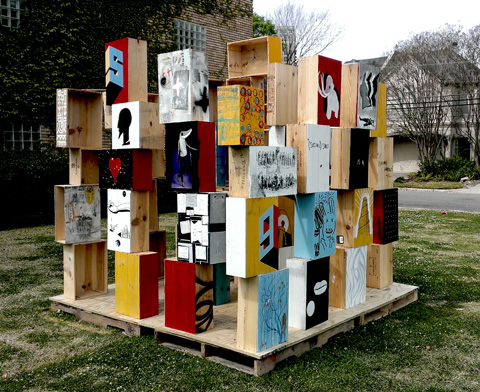
'BOX CITY' Wooden wine boxes and acrylic paint, dimensions variable, 2013, by Rahul Mitra. |
This year’s Portland Museum of Art Biennial may not be the most exciting one, but it is a solid, very good-looking one. Which is not surprising, given that it has a thematic focus and thus a certain coherence instead of the usual jumble. So what this Biennial has lost in liveliness and surprise, it has gained in depth.
“Piece Work,” the title selected by curator of contemporary and modern art Jessica May, is meant to evoke the manufacturing concept of piecework assembly in two distinct ways that often overlap in the current selection of artwork: time-consuming labor of production, and translation between media. Using intensely labor-intensive processes is nothing new and is certainly not a geographically exclusive strain in contemporary art, although there is that supposed hard-working, hands-on attitude in Maine. The concept of “Piece Work” in this sense is broadly defined and surfaces as accumulation, repetition, layering, and increments, and holds up more or less stringently throughout the show.
Traditional feminine handiwork fits well into these parameters, and several updates to it are included in the show. Alison Cooke-Brown’s interventions into lacy gloves, frilly doilies, and the like, are feminist take-offs that, although finding fault with stereotypical feminine qualities, invest just as much care and skill into subverting them. Crystal Cawley’s outfits for a giantess are even more expertly executed and carry a powerful and elegiac undertone that seems a perfect fit for her materials and shapes — a shirt of shredded love letters and a regal cloak of felt embroidered with jigsaw-puzzle pieces — suggesting the complicated nature of comfort and play not just in clothing, but life itself.
The abstract grid of books and boxes in Abbie Read’s installation, “Library,” plays against the very real objects they are and contain. This archive of found and made elements is rich in textures and scales and becomes a memorial resonating with experience. Within her circumscribed vocabulary of botanical elements made from charcoal and black paper, Lauren Fensterstock continues to come up with interesting new formal and conceptual complexities. While referencing an 18th-century landscape border practice, the monumental black rectangle of prairie grass, which contains a ravine of primal, subconscious growth, references not only Earth Art like most of the artist’s work, but also envisions minimalism as a decidedly dystopian form of nature. Along similar lines, Gary Green’s photographs of orderly but alienated nature strike a perfect balance between beauty and the terror of forgetting. Carrie Scanga’s moody night scene extending from a tall wall-mounted monotype to a pool of waves around an old-fashioned riverboat is most memorable for its striking contrasts of weight and solidity between bronze and paper.
Kate Beck’s work fits squarely into the concept of “Piece Work” in multiple ways. Not only is it installed at the center of the show, it is also intensely labor-intensive and consists of a grid of 100 drawings. Dense accumulations of graphite lines, the drawings appear alike yet contain a range of tone, rhythm, and surface that are rich in nuance and sustained attention. Line is also JT Bullitt’s medium and his has even more to do with time than Beck’s. In an abstract yet visceral way, he measures and documents human experience with hand and pen acting as seismographic needle. While not conceptually new, his works have a touching sense of humor and vulnerability. Jocelyn Lee’s photographs of Kara are gripping, touching glimpses of one life not at the kind of events usually recorded by camera, but at seemingly random intervals, the way life mostly unfolds in unremarkable increments. The sensitivity, maturity, and formality of Lee’s vision is superb.